.
.
Dear Readers:
…..This essay was inspired by my recent experiences witnessing the ceremonies commemorating the 80th anniversary of liberation of several World War II concentration camps in Germany.
…..A selection of photos by my companion, the photographer Rhonda R. Dorsett, is found at its conclusion.
Joe Maita
Editor/Publisher
.
.
___
.
.
“We must rebel, we must show strength against the enemies of democracy.”
Former German president Christian Wulff, during his April 6, 2025 keynote speech in Weimar, Germany commemorating the 80th year of the liberation of the Buchenwald concentration camp
.
.
___
.
.
photo by Rhonda R. Dorsett/April, 1945
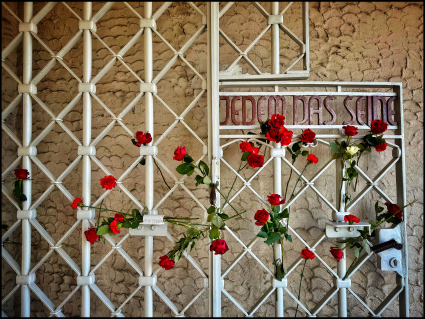
The gate leading into the Buchenwald concentration camp in Weimar, Germany.
The phrase on the gate, “Jedem das Seine,” means “to each his own,” or “to each what he deserves.” The German Schutzstaffel (SS) used the motto to justify their actions, interpreting it as the “master race” deserving power and the ability to humiliate and destroy others.
.
.
1.
War
.
…..The story of my recent trip to The Netherlands, Germany and France begins with my meeting Rhonda R. Dorsett in October of 2023. I swiped right, and there she was. Soulful, inquisitive, creative, humorous, and gorgeous. At the conclusion of a successful career in New York, ten years ago she chose to retire in Portland, where I’ve lived for 47 years. She now focuses on projects that suit her brilliant creative eye. As a professional photographer and adventurous traveler, she sees the world in ways I don’t, which helps me experience it on a surprisingly refreshing level.
…..Her story of the trip begins on April 11, 1945, in Nordhausen, Germany, in the state of Thuringia. After landing in Normandy in June, 1944, her father, Private First Class Walter L. Dorsett, followed his Army unit across France, The Netherlands, Belgium and into Germany, culminating in a role liberating the Boelcke-Kaserne Nazi concentration camp in Nordhausen. Boelcke-Kaserne was a subcamp of the Dora-Mittelbau camp where religious, political and military prisoners supplied the Nazis the slave labor needed to manufacture their V-2 rocket and V-1 flying bombs in enormous tunnels dug deep in the Harz Mountains, safe from Allied bombings. When inmates – treated with unimaginable brutality – were no longer physically able to work, they were often sent to the barracks of Boelcke-Kaserne to die. If this weren’t awful enough, a week prior to its liberation the Royal Air Force bombed Nordhausen, killing 8,800 people, 1,000 of whom were prisoners in the barracks, which the British mistakenly thought housed Luftwaffe, the aerial warfare branch of Nazi Germany’s armed forces.
…..So, this was the scene the 24-year-old Dorsett walked into. Rubble. Piles of human bodies. The stench of murder. A complicit citizenry. America’s soldiers and military leaders who had spent years fighting and witnessing Nazi cruelty said they had never seen anything like it.
.
photo by Walter L. Dorsett, April, 1945/Photo courtesy Rhonda R. Dorsett
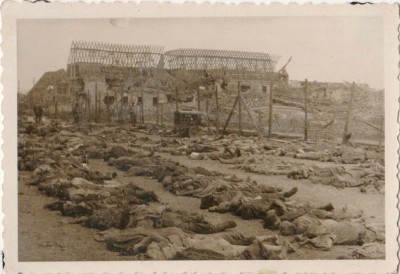
..
…..
,
…..By all accounts Walter Dorsett had a normal childhood. He enjoyed hunting and fishing in his hometown of Ashland, Illinois. Family members recall that he was charming and shy, and a terrific baseball player. Rhonda remembers him telling her that all he ever wanted to do was be a major league player. He made it to the minors, but in 1943, at the age of 23, he was drafted and joined the United States Army. When World War II concluded he returned home and, with wife Wilma, raised three daughters and lived a modest middle-class life as a carpenter.
…..But something wasn’t right. Rhonda’s childhood involved being witness to and subjected to her father’s struggles with anger, something she has been puzzled about throughout her life. It affected her relationship with him, and feelings for him.
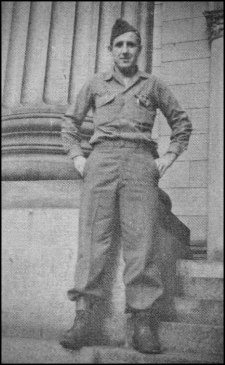
Walter L. Dorsett
.
___
.
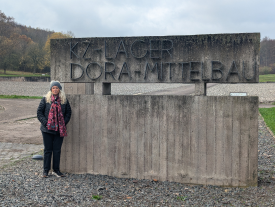
Rhonda, standing at the entrance to Dora-Mittelbau
.
___
.
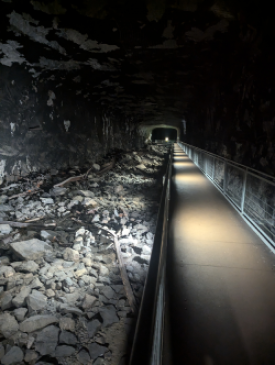
Touring the vast tunneling system of Dora-Mittelbau
…..When she found several photographs her father took during the liberation of Boelcke-Kaserne a few years ago, she became suspect about how this experience may have impacted him and contributed to their difficult relationship. It opened the door to her realization that his wartime duties must have subjected him to a deep psychological trauma that he himself never understood or communicated during his life, and which complicated theirs. This discovery created a newfound compassion for him – perhaps enough to help her inch towards finding a way to love him, 20 years after his passing. It has even led her to the decision to write a memoir about it.
…..To this end, Rhonda has dug into Walter’s history with World War II – especially with his experience assisting in the liberation of Boelcke-Kaserne. It is difficult because many of the Army records of his service aren’t available, and those that are have large unknowns in them; so, like a detective she has pursued leads from any legitimate source. Along the way she has made friends in America, but also in Germany. One in particular – an archivist at Dora-Mittelbau – has been very helpful, and upon hearing that we would be on the European continent in the fall of 2024, invited us to visit the camp, where he would provide Rhonda with as much information as possible as well as give us a private tour of the camp’s notorious tunnels, barrack sites, and crematorium. Rhonda accepted his offer, so in November, 2024 we traveled to Nordhausen in an effort for her to possibly understand Walter’s time spent there. It was a deeply impactful experience that opened our eyes wider to the atrocities of the Nazi fascist regime, and the complicity of the local German population who failed to call out the existence of these camps in their own city.
…..As we left, we were informed about the 80th anniversary of the liberation of the notorious Buchenwald camp and its subcamps Dora-Mittelbau and Boelcke-Kaserne, and were invited to attend the events surrounding them. It was felt that by being there Rhonda could be introduced to dignitaries, local residents, and others who, like her, had family members who played key roles in the camp liberations. It was even possible that survivors of the camps would have stories that could provide clues for her. We put a return visit to Nordhausen in early April in our calendars.
.
___.
.
photo by Rhonda R. Dorsett
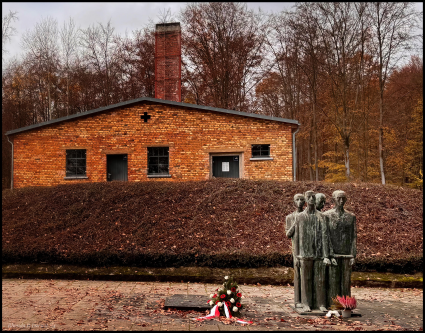
The crematorium at Dora-Mittelbau
.
.
2.
Remembrance
,
…..The city of Nordhausen is the capital of the Nordhausen district in the state of Thuringia, located at the southern end of the Harz Mountains. Like many cities in Germany, it was devastated during World War II, and its years spent within the grip of the Soviet Union meant that much of what was rebuilt was with concrete in the bare building, Brutalist style architecture. If you’re looking for old-world European charm, Nordhausen is not the place to find it.
…..Because of its notorious World War II history due to Dora-Mittelbau and Boelcke-Kaserne, and its close proximity to Buchenwald and Bergen-Belsen, Nordhausen is a geographic center for remembrance. Since the end of the war it has hosted many liberation commemorations, and the week of April 6, 2025 marked the 80th.
…..The invitation we accepted from the gracious German people became an unforgettable three-day experience. Those who attended the ceremonies included citizens from all over Europe – Germany, especially, but also France, England, Russia, Ukraine, as well as a handful from the United States. Local, national, and international dignitaries spoke, and we met citizens who carry with them stories from ancestors who witnessed the liberation of camps. A dozen or so survivors of the camps attended, including 100-year-old Albrecht Weinberg, who endured the hell of three of them.
…..Over three days, Rhonda and I attended emotionally powerful events that focused on the importance of remembrance – of human struggle, of lives lost, and, most importantly, of an uncommon evil based on hatred of the “other” and on unfounded conspiracies that infiltrated a modern, civilized country. One speaker after another declared that Germany, and the world, must never again allow fascism to take root.

Former German president Christian Wulff
…..Many citizens of the world see the policies and actions of the current American president creeping the country ever closer towards authoritarianism. Germany has real history with this – one the Western world can learn from – and its mainstream political parties and populace are diligently toiling to fend off the right-wing extremists in the Alternative for Germany (AfD) party. This is the party that in February Vice President J.D. Vance met with and endorsed as a political partner – a party disseminating many of the same populist anti-immigrant/anti-government messages the Nazi party used prior to World War II. In his April 6 keynote address to the attendees of the Buchenwald ceremony held in the city of Weimar, former German president Christian Wulff rebutted that thinking, explaining that “the integration of right-wing extremists, in any form, does not disenchant them; rather, it strengthens them, because they use their power to undermine the liberal constitutional state and push through their anti-democratic agenda. Later, they mock democracy, claiming it granted them privileges to abolish it.”
…..So, there is currently a lot at stake for the German people – and the rest of the world, There was also much for me to learn, and to experience on a personal level. Two events especially stood out for me.
…..The first took place during the commemoration at the Dora-Mittelbau camp, which was held on a gently sloped hillside and adjacent to the camp’s crematorium. It is a somber place at the foot of the Harz Mountains that housed the enormous tunnels in which young men like Albrecht Weinberg worked, and where many of his fellow slave laborers died.
…..A crowd of several hundred people were gathered quietly, and speakers rose to share their thoughts. One was a young woman from Ukraine whose grandfather was subjected to Nazi persecution and survived three concentration camps, only to be killed during a Russian airstrike in Kharkiv in 2022. She gave a brief, emotionally powerful speech about the personal sadness of losing family members and friends to war, and living in a country under relentless siege, attacked by a foe hellbent on overturning their democracy. After the speakers concluded, the crowd walked slowly among the many wreaths of flowers, taking photographs and quietly mingling. In the distance, I noticed Albrecht being transported by wheelchair slowly up the hill leading into the crematorium.
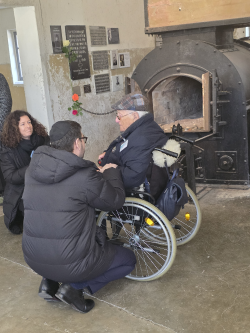
…..The idea of entering a concentration camp crematorium is not something I’ve had on my vacation bucket list – and in fact, during my first trip to Dora-Mittelbau in November I was so overwhelmed with emotion upon entering it that I turned around and walked rapidly back to the entrance of the memorial. This time, however, I was determined to see Albrecht’s experience within it. I followed him inside, where a handful of people were gathered in silence. It is a large concrete room, and its centerpiece is a horizontally shaped oven. It is a shocking sight. Unimaginable. Horrific. But getting through this shock and allowing myself to be there offered me an opportunity to witness a remarkable human moment.
…..After being inside for a short time, Albrecht asked to be wheeled to a wall beside the oven. On it were plaques commemorating prisoners who died in Dora-Mittelbau, their bodies among the many disposed of in the oven. Those of us inside remained silent as he began to rap with his hand and talk aloud to it. While it was difficult to understand all he said, in a resolute, powerful voice, he directed his speech to people he knew during the time he was imprisoned. He was animated, passionate, at times even humorous, and his message – spoken in English – echoed throughout the space; “I am still here! I am still here!”
…..And, indeed he was. Still here for his stories to continue to be seen and heard. Still here to be a reminder to those who pretend the evil of Nazi fascism didn’t exist, or that it can’t happen again. And still here to mock the spirits of those who inhumanely incarcerated him as a young man, and who manned this oven. It was a deeply profound experience for me, as was meeting him personally the following morning.
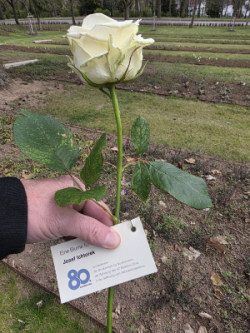
…..The second special event took place at the cemetery in Nordhausen. I hesitate to refer to it as a “cemetery” because it really is a mass grave where the prisoners who died at Boelcke-Kaserne are buried. I learned that they found their final resting place in this flat and unremarkable place after soldiers like Walter L. Dorsett walked into the camp’s horrors and, after talking to local residents who claimed to know nothing of the camp’s existence, forced those very citizens to bury the thousands of victims who died at the hands of the Nazis. At the conclusion of the official ceremony, I was handed a white rose to place anywhere on the mass grave in remembrance of one of the victims, Josef Ichtorek. I took a moment to reflect on who Josef may have been, what he must have endured, and the life he lost before finding an appropriate place on which to place the rose. I felt deeply honored to do so.
…..Attending these commemorations was challenging emotionally, but they re-acquainted Rhonda and me with the horrors of the past while introducing us to the grace of those present who gathered for the purpose of remembering the victims of Nazi atrocities. Rhonda was able to meet people who connected her closer to her father’s story, and who may possibly help with her continuing research. And, since we were among only a handful of Americans present, we felt an important responsibility in representing our country, as well as a significant sense of pride on being reminded that our parents’ generation played such a positive role in freeing Western Europe from fascism.
.
___.
.
.
photo by Rhonda R. Dorsett
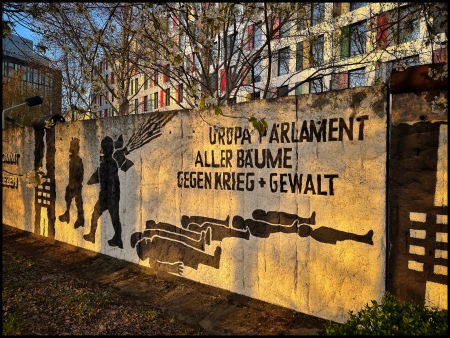
A portion of the remains of the Berlin Wall
.
3.
Walls
.
…..If you are fortunate enough to get to age 71 – which I am – you will have enjoyed and been challenged by major personal events that can be reflected on and learned from. For me, these major events involve education, career, marriage, the raising of children, the death of parents, retirement, divorce, and, thankfully, rejuvenation, the stage I am now in. There are also the major events that our country and world experienced together that we expect our leaders (and those who elect them) to learn from. A list for fellow boomers would include the assassinations of political and civil rights leaders, the Vietnam war, Watergate, and September 11 and America’s response to it.
…..After this trip I’ve concluded that the Cold War and particularly the fall of the Berlin Wall in 1989 is the most consequential event of my lifetime, and one vitally important to learn from. It was built in 1961 by an authoritarian state for the purpose of fencing freedom and human dignity out, which meant enormous risk was taken by people attempting to escape from East to West. There are monuments all over Berlin devoted to these attempts, and to those who lost their lives. (There are, of course, other monuments throughout Europe devoted to those who succumbed to a different authoritarian. Evidence of Hitler’s narcissism and regime of hate is everywhere – on the 75,000 bronze “stumbling stones” outside the homes of Jewish families who were kidnapped and sent to the gas chambers of Auschwitz; cemeteries filled with Dutch resistance fighters; mass murder sites of the Maquis and innocent civilians on the hillsides of Beyssanac, France; the thousands of monuments in major cities and small villages honoring the World War I and World War II war dead; and, of course, the countless Holocaust memorials all over the continent).
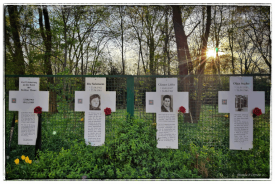
Part of the monument remembering East Berlin citizens killed while attempting escape to the West
.
___
.
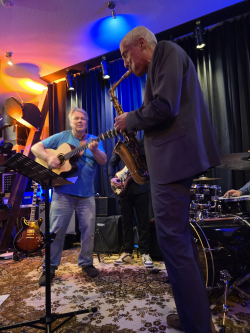
Ro Gebhardt (guitar); Jan von Klewitz (saxophone) at Jazzclub Nordhausen, April 5, 2025
…..But when the Berlin Wall came down, hope emerged. Countries with complex historic interactions formed alliances. Travel and trade became easier. Economies grew. People were united with families, and for many, freedom was experienced for the very first time. We now tend to take these freedoms for granted, but on occasion there are reminders of how different the world is in 2025 compared to 1989. For example, one night in a small Nordhausen club, while Rhonda and I sat with a classic German lager four feet from a sensational jazz quartet playing American jazz standards, I couldn’t help but think that, other than the occasional U.S. State Department- sponsored tours of jazz musicians, the only interaction the average person living behind the Iron Curtain could have had with jazz was with records smuggled in from Western countries. That’s pretty much it.
…..So, this notion of a wall and the inhumanity and human suffering it can represent has stuck with me since returning from my trip in late May. Because walls – whether physical or metaphorical, and built by authoritarians and their sycophantic politicians and citizenry whose dreadful legacies litter the whole of Europe – incarcerate innocent people like Albrecht Weinberg and eventually require soldiers like Walter L. Dorsett to liberate them. The human cost paid by everyone – including those in succeeding generations like Walter’s daughter Rhonda – is enormous.
…..With this in mind, I’ve added another “event” of significance that has occurred during my lifetime that we will hopefully immediately learn from – an event that my trip helped me see clearer – and that is America’s current political turmoil, which began with Donald Trump’s classic populist and authoritarian proclamation to “build a wall” in order to keep migrants from Central America out of the United States. You don’t hear much from him about the need for a physical wall anymore – instead, he revels at the notion of threatening individual citizens and foreign students in the country legally who cross him politically with deportation. And, he simply employs members of his own government who complicitly muscle people he deems unworthy out of the country, often without due process and more often with the encouragement of an uncomfortable number of fellow Americans – and the courts.
…..SSo, make no mistake, Trump is building a wall, and this time it is much more sinister than a physical barrier because it is being built grievance-by-grievance, all the while separating us from the truth and our personal freedoms while pitting country against country, state against state, American institution against American institution, people against people.
…..Building walls like this one is what authoritarians do, and they often do so with the consent of politicians, citizens, and institutions who want to solve what appear to be unsolvable issues – many of which are fabricated – and do so by circumventing democracy. But those cheering on the construction of Trump’s menacing new wall may want to be reminded that, as the likes of Albrecht Weinberg, PFC Walter L. Dorsett, and the entire country of Germany learned, they are mighty difficult to bring down.
.
Joe Maita
Editor/Publisher
.
.
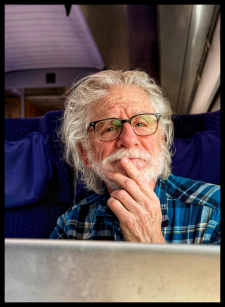
.
.
___
.
.
Postscript
.
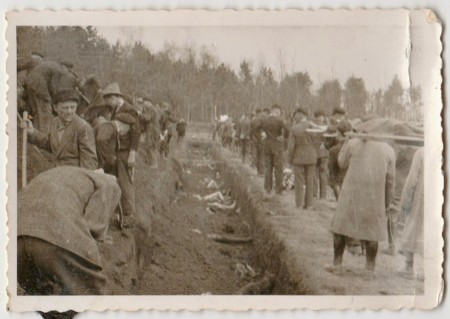
,
When the 3rd Armored Division entered Nordhausen on April 11 ,1945, they discovered unimaginable horrors – countless dead and dying. In Stephen Ambrose’s World War II history Citizen Soldiers, he writes that General [Joseph Lawton] Collins “ordered that every civilian in Nordhausen had to work around the clock until the bodies were buried.” This photo of the mass grave, by PFC Walter L. Dorsett, is of that work.
Ambrose reported that one of the soldiers entering Nordhausen was Lt. Hugh Carey, who would eventually became governor of New York in the 1980’s. Its impact on Carey was dramatic. Thirty years after the war, he wrote; “I stood with other American soldiers before Nordhausen. I inhaled the stench of death, and the barbaric, calculated cruelty. I made a vow as I stood there that as long as I live, I will fight for peace, for the rights of mankind and against any form of hate, bias and prejudice.”
.
May we hope our own Nordhausen experience won’t be required before all Americans make that vow.
.
.
________
.
.
A Photo Essay
.
The following photos are moments from our personal journey, and were taken in the fall of 2024 and the spring of 2025. I publish them as a reminder of the human and civilizational cost of authoritarianism and fascism. They represent but a small portion of the thousands of World War II memorials in Europe.
Brief captions of these people and places accompany the photos. Interested readers can of course get more complete information on Wikipedia or via a web search.
Unless otherwise noted, all of the following photos are ©Rhonda R. Dorsett
.
.
___
.
.
Dutch resistance fighter Jannetje Johanna (Jo) Schaft became known as “the girl with the red hair.” Within the Resistance she was known as “Hannie.” She did a variety of courageous work, including stealing ID cards for Jewish residents, and attacking, sabotaging and assassinating Germans, Dutch Nazis, collaborators and traitors. Before facing her targets, Schaft put on makeup – including lipstick and mascara – and styled her hair. “I’ll die clean and beautiful,” she said.
She was eventually arrested at a military checkpoint in Haarlem on March 21, 1945 while transporting secret documentation for the Resistance, and executed by Dutch Nazi officials on April 17, 1945, three weeks before the end of the war. She is buried in the dunes of Overveen at Bloemendaal Cemetary, near where she was murdered at the age of 25. (1)
.
.

The Hannie Schaft monument in Haarlem, Netherlands, was created by the sculptor, painter, and Hannie’s fellow resistance fighter Truus Menger-Oversteegen. The statue, unveiled in 1982, depicts Hannie in a posture of defiance.
.
.
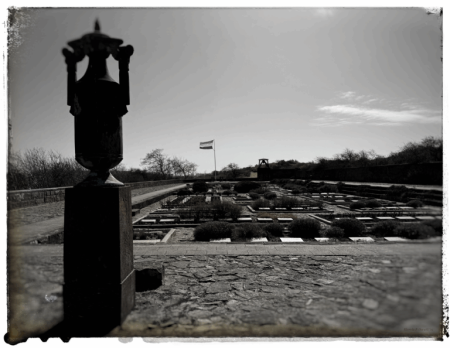
The Dutch Honorary Cemetery in Bloemendaal, where Hannie is buried. Members of the Dutch government and royal family attended her November, 1945 funeral, including Queen Wilhelmina, who called her “the symbol of the Resistance.”
.
.
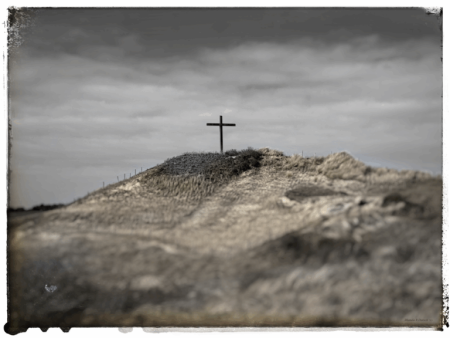
A photo taken from near the spot of where Hannie rests now. The cross on the hill marks the place where over 100 bodies of resistance fighters were found buried by the Nazis. Hannie was the only female.
.
.
___
.
.
Walk just about anywhere in Europe and you will encounter brass plates known as “stumbling stones” (a.k.a. “Stolperstein”) that are installed in the pavement in front of the last voluntarily chosen place of residence of victims of the Nazi regime. They serve as a memorial and a reminder of their stories, and of the atrocities carried about by fascists.
The plaques detail their year of birth, the date they were taken from their home, and their destination.
.
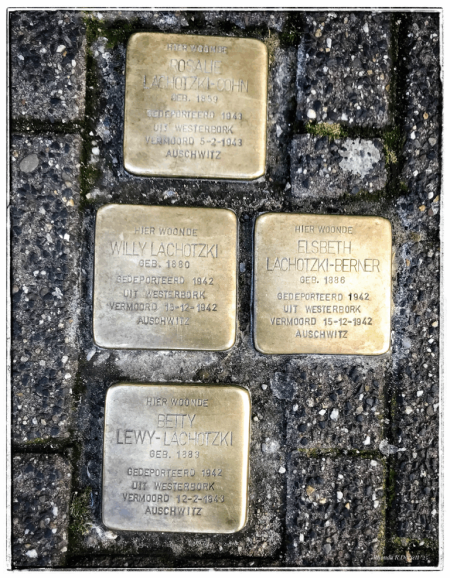
Amsterdam
.
.
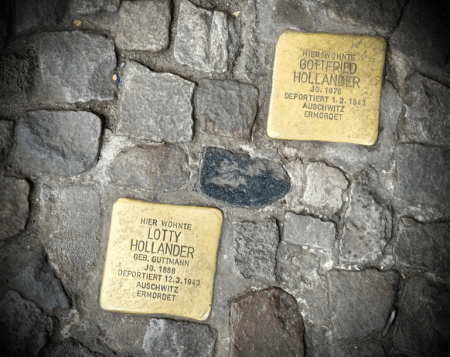
Berlin
.
.
___
.
.
Monuments honoring victims of the Nazis are deeply moving and offer repeated reminders of the cruelty of fascism, and the enormity of it.
.

This bronze sculpture commemorating the Kindertransport rescue mission from Nazi Germany is outside the Dammtor railway station in Hamburg, Germany. Between December, 1938 and the start of the war on September 1, 1939, thousands of Jewish children were sent from Germany to the United Kingdom and other countries on rescue transports, including around 1,000 Jewish children from Hamburg. In many cases, the children were the only members of their family to survive. (2)
.
.

The Memorial to the Martyrs of the Deportation in Paris is dedicated to the 200,000 people who were deported from Vichy France to the Nazi concentration camps – often with the assistance of French citizens themselves – and was inaugurated by French president Charles de Gaulle in 1962.
The memorial features excerpts of works by Louis Aragon, French poet and French Resistance member Robert Desnos, Antoine de Saint-Exupéry and Jean-Paul Sartre. Fragments of two poems by Desnos, himself a deportee, are inscribed on the walls. The first consists of the last stanza of a poem written pseudonymously by Desnos and published “underground” in Paris on Bastille Day, 1942
“The Heart that Hated War”
I have dreamt so very much of you,
I have walked so much,
Loved your shadow so much,
That nothing more is left to me of you.
All that remains to me is to be the shadow among shadows
To be a hundred times more of a shadow than the shadow
To be the shadow that will come and come again into
your sunny life. (3)
.
.
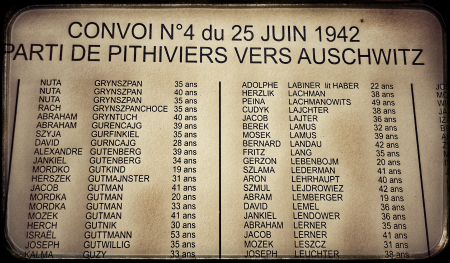
A plaque listing only a handful of Jewish residents of France who were taken from their homes by the Nazis by train to the Pithiviers internment camp, 37 kilometers outside of the city of Orleans. Most of the inmates of the camp were sent to Auschwitz concentration camp, where they were murdered. (4)
,
,
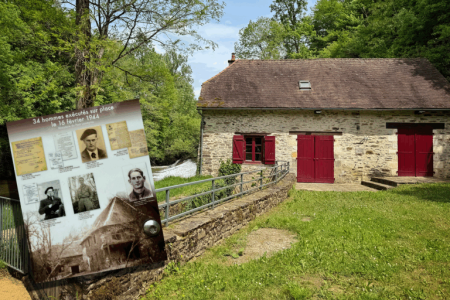
On February 16, 1944, this Papeterie mill near Beyssanac, France was home to around 50 Compulsory Work Service (STO), young French men who were avoiding being drafted by the Germans, and who had no choice but to go into hiding. After having been discovered by a German platoon, 34 of them were executed at this site, 13 were deported (seven escaped), and three survived the attack. All these young men were waiting to form the Bataillon Violette, a resistance battalion which was formed in June 1944. The mill is now a place of remembrance, and home to an extensive outdoor exhibition recounting the heroic (and horrific) events. (5)
.
.
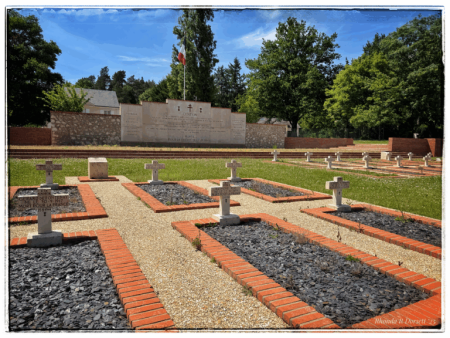
We came upon this sacred place while driving north toward Orleans, just outside the village of Salogne, a center of French resistance. Many of those buried here died during skirmishes with the Nazis. Most were teenagers, outnumbered by the Germans 10 to 1. (6)
.
.
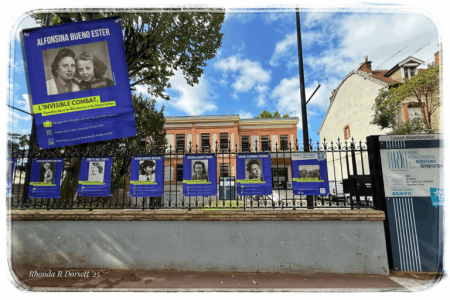
There are countless French Resistance museums throughout the country, including this extensive one in Toulouse, a glorious city with a history of political and military resistance.
The French Resistance was made up of a collection of groups that fought the Nazi occupation and the collaborationist Vichy regime. The Resistance cells were small groups of armed men and women (the Maquis) who conducted guerrilla warfare and published underground newspapers. They also provided first-hand intelligence information, and escape networks that helped Allied soldiers and airmen trapped behind German lines. They rescued and saved many Air Force pilots and paratroopers, guiding them across the treacherous mountains into Spain. The Resistance’s men and women came from many parts of French society, including émigrés, academics, students, aristocrats, and members of virtually every religious group. The proportion of French people who participated in organized resistance has been estimated at from one to three percent of the total population. (7) Their participation was invaluable to the Allied war efforts.
.
.

The Memorial to the Murdered Jews of Europe, also known as the Holocaust Memorial, in Berlin. It is made up of 2,711 concrete slabs (stelae) of many heights, and arranged in a grid pattern on a sloping field.
According to the architect Peter Eisenman’s project text, the stelae are designed to “produce an uneasy, confusing atmosphere, and the whole sculpture aims to represent a supposedly ordered system that has lost touch with human reason.” We wandered among the monument for an hour, struck by the design and the hold it had over us. It is a somber experience, and its sheer mass can’t help but make reflective visitors feel the enormity of man’s cruelty to his fellow man, and the suffering of the six million Jews murdered during World War II. A museum of major importance is below the monument.
,
,
___
.
.
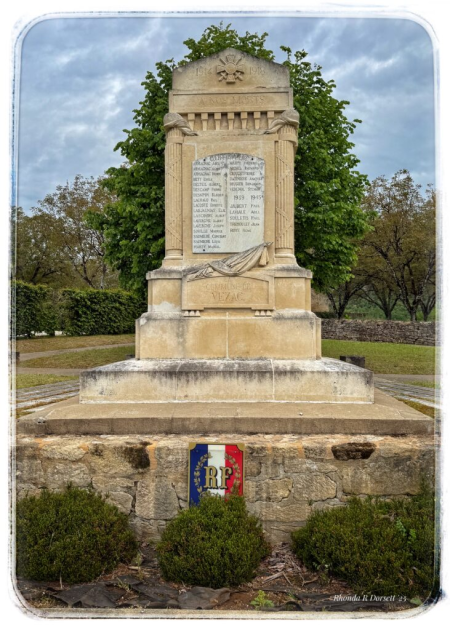
In virtually every village in France, monuments like this one in Vézac were erected (mostly after World War I) honoring the fallen of both world wars. “Mort Pour La France” (“Died for France”) is a constant reminder of the suffering, as are the names of the soldiers. In many cases, family names were represented multiple times – brothers and cousins, all dying while defending France.
.
.
___
.
.
Anne Frank is the name we associate with the holocaust. I was inspired to re-read her story during my journey, and we found many landmarks, monuments, and gardens honoring her memory.
.
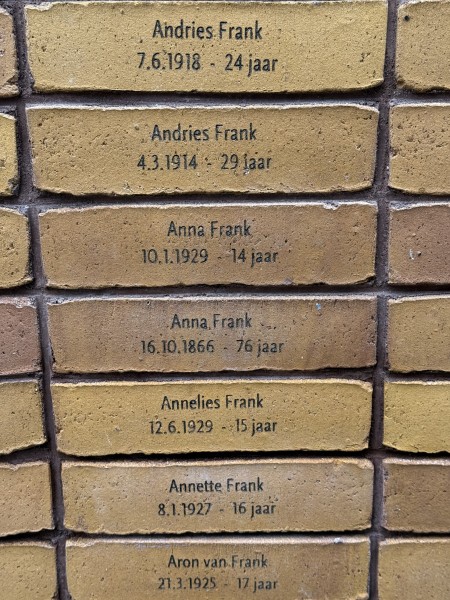
The wall at the holocaust memorial in Amsterdam, where Anne lived in hiding from the Nazis.
.
.
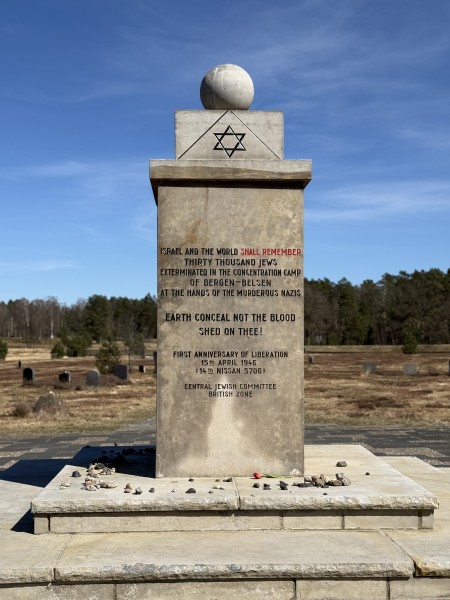
The monument at the Bergen-Belsen concentration camp, southwest of the town of Bergen, where she was murdered.
.
.
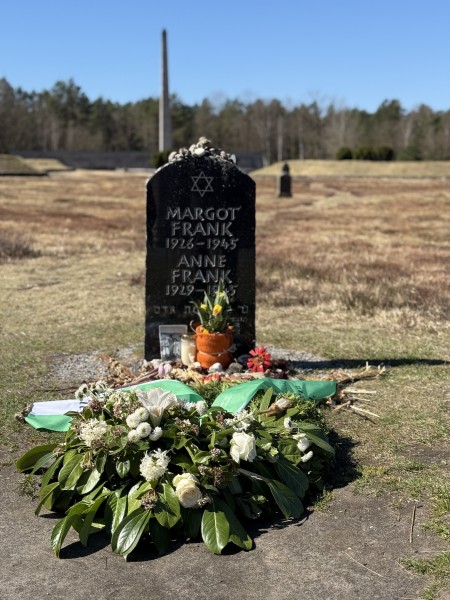
The symbolic grave marker of Anne and sister Margot at Bergen-Belsen. She is buried among thousands in one of the many mass graves within the camp. Walking among them, it is impossible not to feel all of the lost lives, and the depravity of fascism.
.
.
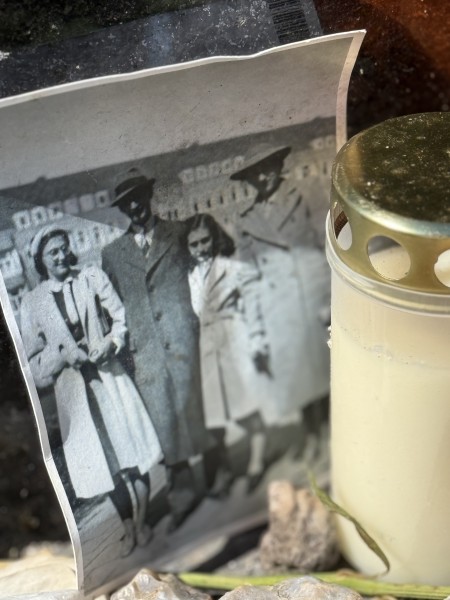
At the foot of Anne’s grave – rocks, a candle, and a photo…
.
.
___
.
.
Scenes from Dora-Mittelbau in Nordhausen, one of over 40,000 Nazi concentration camps in Europe during World War II
.
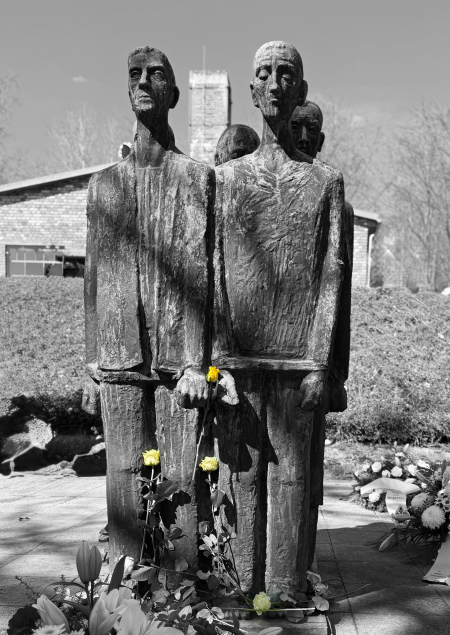
A memorial square was constructed in front of the crematorium in the early 1950s. This sculpture – a group of five figures bound at the hands – is by the sculptor Jürgen von Woyski, and has occupied the center of this space since 1964.
After 1990, three commemorative signs were added to the square. Two stone slabs are respectively dedicated to Jewish victims and Sinti and Roma victims of the concentration camp. Another stone slab lists all the nations of origin of the inmates of Mittelbau-Dora concentration camp and is dedicated to all the victims. (8)
.
.
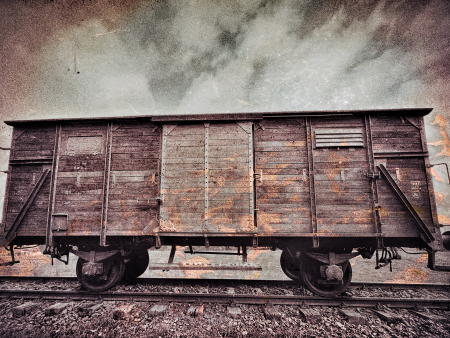
A rail car within the camp representative of those used to transport innocent people to the camp.
.
.
photo by Joe Maita

Rhonda with our guide, inside one of the tunnels where the V-2 rocket and V-1 flying bombs were built.
,
.
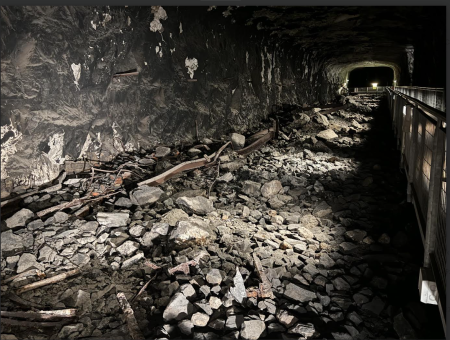
Thousands of inmates at a time worked within the massive tunnel system of Dora-Mittelbau. They worked under armed guard and often without sleep, and with very little food and water. Their toilets were rough cut steel barrels.
.
.
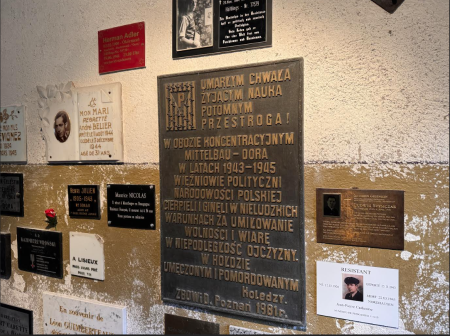
A wall of plaques inside the camp’s crematorium, dedicated to just some of those who didn’t make it out.
.
.
___
.
.
Our experience during the commemoration events at Buchenwald (and following)
,
.
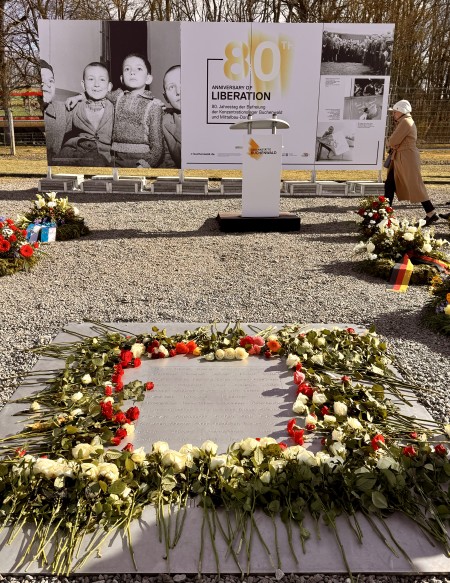
Located on the outskirts of Weimar, Germany, Buchenwald was one of the first and the largest of the concentration camps within the Old Reich territories. Many actual or suspected communists were among the first internees.
Prisoners came from all over Europe and the Soviet Union, and included Jews, Poles, and other Slavs, the mentally ill, and physically disabled, political prisoners, Roma, Freemasons, and prisoners of war. There were also ordinary criminals and those perceived as sexual deviants by the Nazi regime. All prisoners worked primarily as forced labor in local armaments factories. The insufficient food and poor conditions, as well as deliberate executions, led to 56,545 deaths at Buchenwald of the 280,000 prisoners who passed through the camp and its 139 subcamps. It was liberated by the U.S. Army in April, 1945. (9)
.
.
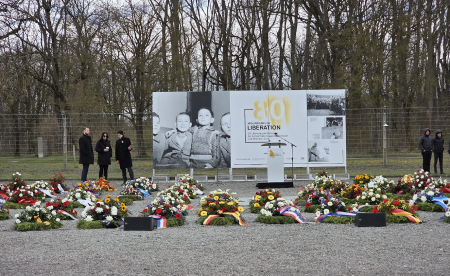
Countries from all over the world were represented in the form of dignitaries, private citizens, and symbolically by wreaths of flowers laid on the ground.
.
.
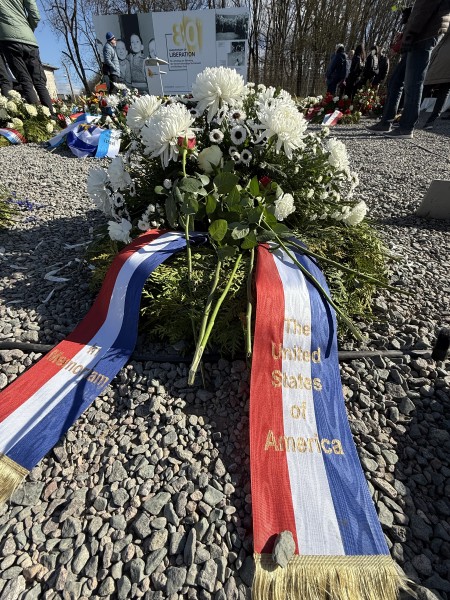
There were a smattering of Americans (and this wreath) among the attendees. Several speakers took the stage – mostly local dignitaries – and their messages always centered on freedom and the importance of preserving democracy and fighting the spread of fascism.
.
.

An unforgettable life experience was having the privilege of meeting 100-year-old Albrecht Weinberg, survivor of three World War II concentration camps. Incredibly smart and filled with kindness and an exuberance for life. You can read about his life in his book, D
.
.

Rhonda and myself…with Albrecht, who I will always remember.
And, I hope this essay, and these photos, help remind us to learn from our history, and to be on the right side of it.
.
Show strength against the enemies of democracy.
.
.
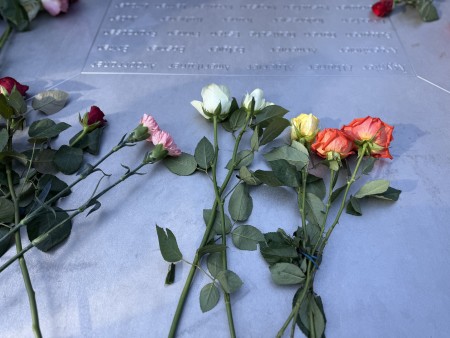
.
.
___
.
.
Watch a video of Albrecht Weinberg enjoying a brief piano piece
.
.
___
.
.
Footnotes
(1) Wikipedia
(2) Memorials in Hamburg
(3) Wikipedia
(4) Wikipedia
(5) Le Pont Lasveyras
(6) Wikipedia
(7) Wikipedia
(8) Mittelbau-Dora Memorial
(9) Wikipedia
.
.
___
.
.
Click for:
“Creatives: This is Our Time!” – a letter from the publisher
More poetry on Jerry Jazz Musician
“Saharan Blues on the Seine,” Aishatu Ado’s winning story in the 68th Jerry Jazz Musician Short Fiction Contest
More short fiction on Jerry Jazz Musician
Information about how to submit your poetry or short fiction
Subscribe to the (free) Jerry Jazz Musician quarterly newsletter
Helping to support the ongoing publication of Jerry Jazz Musician, and to keep it commercial-free (thank you!)
.
___
.
.
Jerry Jazz Musician…human produced since 1999
.
.
.






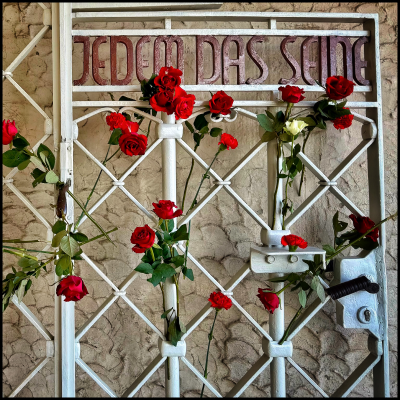
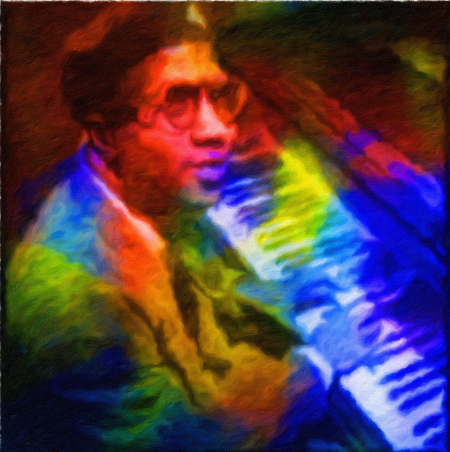
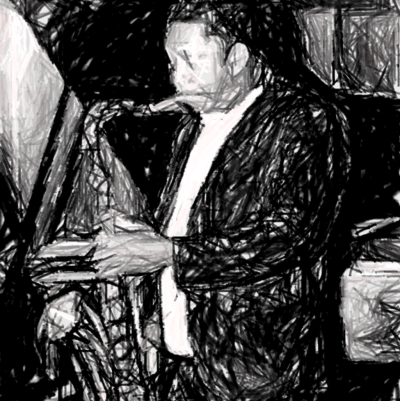
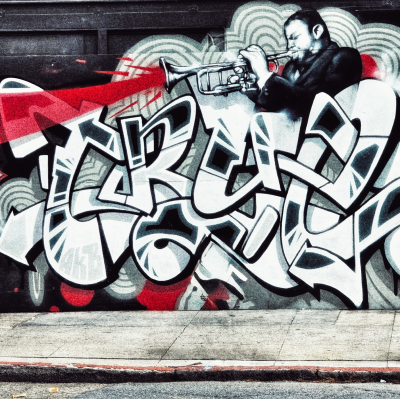

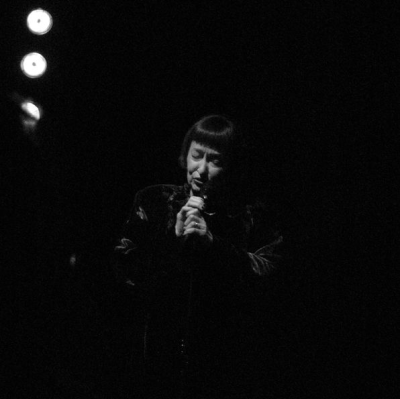
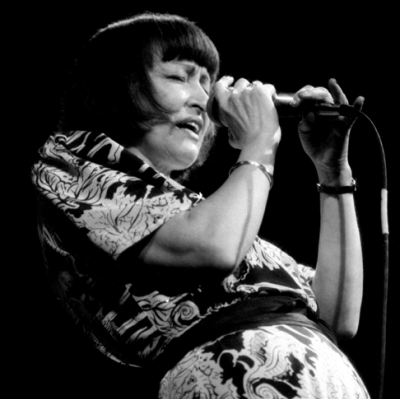
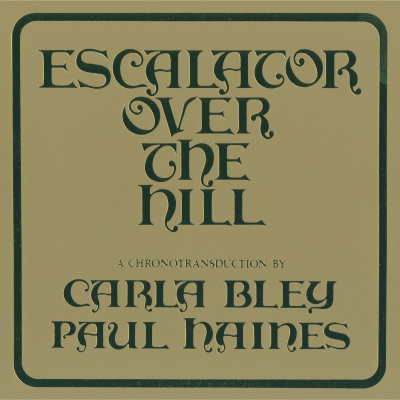
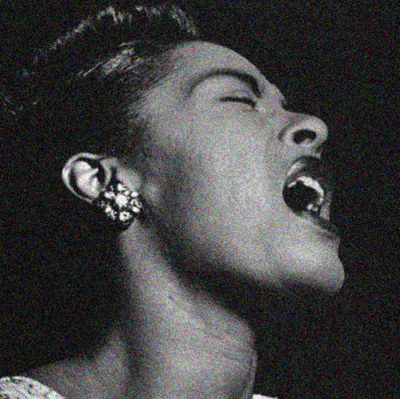
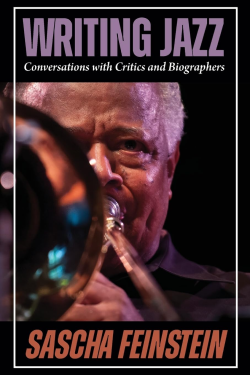

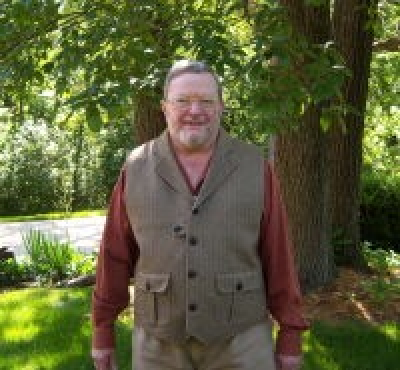
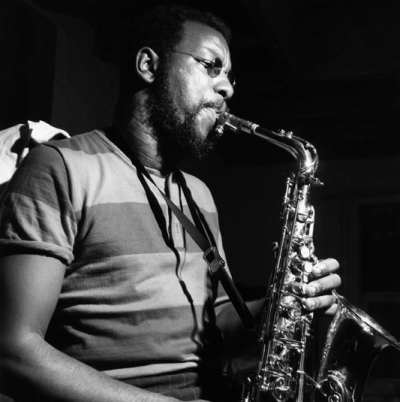
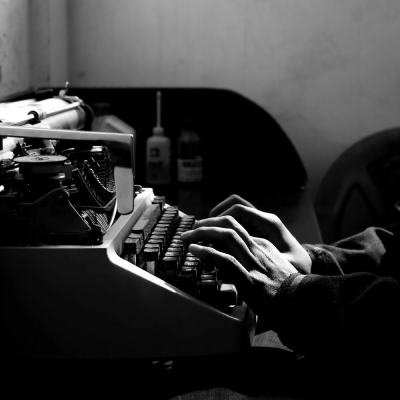

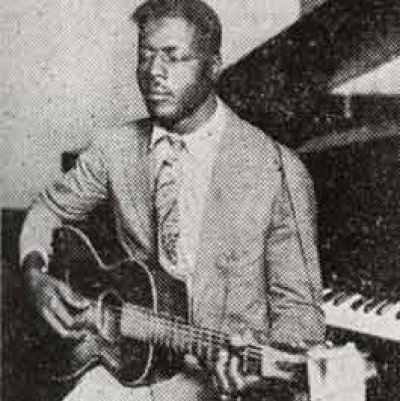
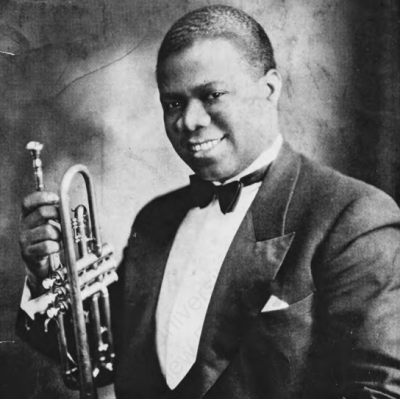
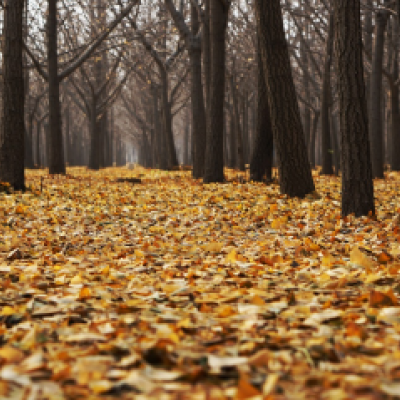
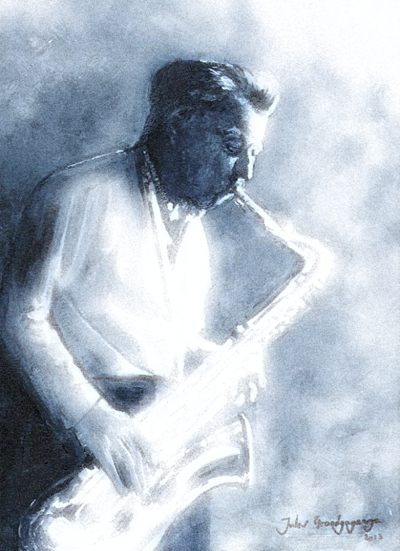


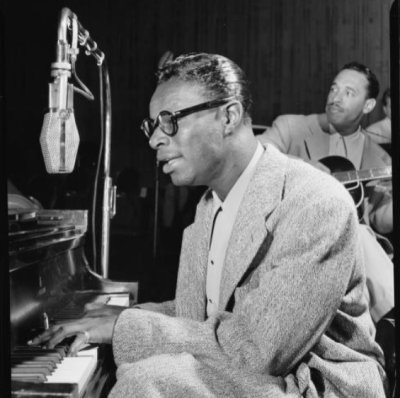

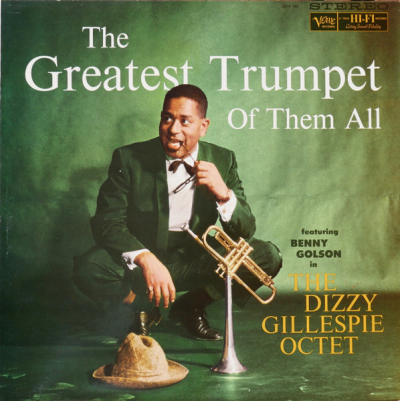








Joe and Rhonda:
Together you shared an extraordinary and life-changing experience. Your essay and photographs are a sobering reminder of where political ruthlessness and inhumanity can lead us….
A very moving and apt essay. Thank you for this insight, Joe and Rhonda. You show us the importance of remaining vigilant and, most importantly, never losing faith.